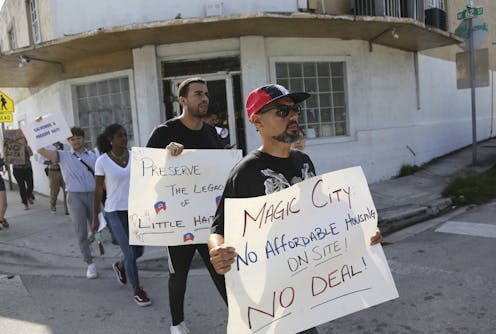What’s really driving ‘climate gentrification’ in Miami? It isn’t fear of sea-level rise
- Written by Richard Grant, Professor of Geography and Urban Studies, University of Miami

Miami’s Little Haiti has been an immigrant community for decades. Its streets are lined with small homes and colorful shops that cater to the neighborhood, a predominantly Afro-Caribbean population with a median household income well below Miami’s[1].
But Little Haiti’s character may be changing.
A $1 billion real estate development[2] called the Magic City Innovation District is planned in the neighborhood, with luxury high-rise apartments[3], high-end shops and glass office towers.
The developers emphasize their commitment to sustainability[5]. But high-end real estate investments like this raise property values, pushing up property taxes and the cost of living for surrounding neighborhoods.
The potential effect on shops and homeowners and on the culture of the community has stoked controversy[6] and protests. Nearby strip malls[7] have been bought up for new development, leaving long-time businesses with fewer affordable options. Other big developments[8] are now being planned.
Some media[9] and urban scholars have labeled what’s happening here “climate gentrification[10].”
It’s the idea that investors and homebuyers are changing their behavior and moving from coastal areas into poorer, higher-elevation neighborhoods like Little Haiti, which sits on a ridge less than a mile from the bay, in anticipation of worsening climate change risks, such as sea-level rise. Miami is often held up as an example.
But are Miami’s investors and homebuyers really motivated by climate change?
A different kind of gentrification
The story goes that Miami homebuyers are abandoning the coasts – where high tides can already bring street flooding in some areas – and are looking for higher-elevation areas because they want to escape climate change.
That isn’t what we’re finding, though.
In Yale’s Climate Opinion Survey[11] of Miami-Dade County in 2021, only half of Miami residents said they believe global warming will harm them personally – far lower than the 70% who said that in Delaware and the 90% in Canada, Western Europe and Japan[12]. Another survey found 40%[13] of Miami-Dade residents weren’t concerned about the impact climate change might have on the market.
In a new study, our team at the University of Miami found a more nuanced picture[14] of what is actually pushing homeowners to higher ground.
For the most part, we found that the shift away from the coasts is fueled by costs. Flood risk plays a role through the rising cost of flood insurance, but much of the shift is plain old gentrification – developers looking for cheaper land and spinning it as a more sustainable choice to win over public officials and future residents.
Rather than bottom-up pressure built on residents’ alarm about sea-level rise, we found a continuation of the usual rational investment decisions.
Developers are driving the process
Present-day “climate gentrification” in Miami is largely determined and driven by capitalist investment opportunities[15] – relatively lower prices and greater expected returns – which are the characteristics of the traditional gentrification process.
We found that neither homebuyers nor real estate agents are driving this process today in Miami. Rather, developers are using the concept of climate risk to market properties[16] in more elevated areas and are working in tandem with policymakers to facilitate urban redevelopment.
Miami is very different from other global cities, in that its wealthy homebuyers and second-home buyers exhibit fewer concerns about rising sea levels and climate change. A large percentage of Miami homebuyers – about 13% in 2021[17] – don’t live in the U.S. and may evaluate risk differently[18], seeing Miami properties as safer investments than they have at home or as future second homes.
Miami’s gentrification also isn’t limited to higher-elevation neighborhoods. In coastal areas such as Miami Beach[19], taxes and housing and rental prices are rising, and poorer people are being pushed out of neighborhoods. Miami’s average rent is now over $2,800 a month[20], up 16% from October 2021 to October 2022. That’s about $800 higher than the U.S. average, and it rose at nearly twice the national rate over the past year.
Coastal homebuyers should be more concerned
Climate change is without question a risk for Miami. The insurance industry warns that sea-level rise[21] and moderate flooding of up to 1 foot will affect 48% of total properties in oceanfront Miami-Dade County by 2050.
Homebuyers should be more concerned than they are.
We believe “climate gentrification” is a meaningful concept for exploring how the impacts and costs of climate change will shift housing and urban inequalities in the future. But so far, the idea that gentrification is fueled by climate change in Miami[22] doesn’t match reality.
References
- ^ well below Miami’s (www.floridahealth.gov)
- ^ $1 billion real estate development (magiccitydistrict.com)
- ^ high-rise apartments (magiccitydistrict.com)
- ^ Joe Raedle/Getty Images (www.gettyimages.com)
- ^ emphasize their commitment to sustainability (magiccitydistrict.com)
- ^ stoked controversy (static1.squarespace.com)
- ^ strip malls (therealdeal.com)
- ^ Other big developments (www.miaminewtimes.com)
- ^ media (www.cnn.com)
- ^ climate gentrification (doi.org)
- ^ Yale’s Climate Opinion Survey (climatecommunication.yale.edu)
- ^ 90% in Canada, Western Europe and Japan (www.nature.com)
- ^ found 40% (www.miamiherald.com)
- ^ a more nuanced picture (doi.org)
- ^ driven by capitalist investment opportunities (doi.org)
- ^ using the concept of climate risk to market properties (doi.org)
- ^ about 13% in 2021 (www.miamirealtors.com)
- ^ may evaluate risk differently (www.ucpress.edu)
- ^ Miami Beach (en.wikipedia.org)
- ^ over $2,800 a month (business.fau.edu)
- ^ warns that sea-level rise (www.mckinsey.com)
- ^ the idea that gentrification is fueled by climate change in Miami (doi.org)







